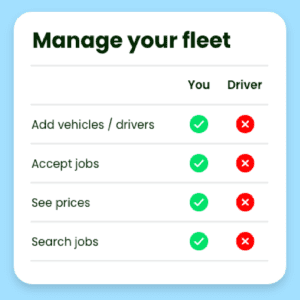Home > Blog > The Comprehensive Guide for Courier Driver Jobs
The world is changing and the way customers buy their items is changing too. The Courier, Express and Parcel (CEP) industry is booming, reaching a staggering £13.5 billion market value in 2024. The explosive growth is fuelled by technology and the emergence of innovative delivery models such as same-day, instant and even drone deliveries.
At the heart of it all, it’s you the courier driver, that makes it happen. You’re the one keeping industries moving, retaining market growth and servicing the increasing demand. Courier drivers are responsible for collecting and delivering goods and parcels safely to customers, from food deliveries and small consumer items such as clothing to larger commercial items such as furniture and electronics.
Technology is your new copilot! Recent advancements have transformed the CEP industry, making deliveries faster and more transparent than ever. Technology developments have unlocked capabilities such as route optimisation, real-time tracking and seamless analytics. Mobile apps streamlining these capabilities are revolutionising the game; 70% of logistics companies have already integrated mobile apps into their daily operations and 85% of these reported higher customer satisfaction as a result.
This guide will equip you with the knowledge and resources you need, to thrive as a courier driver:
Ready to take the wheel? Let’s get started!
The terms ‘courier driver’ and ‘delivery driver’ are often used interchangeably, causing some confusion. Whilst there is some overlap, distinctions exist. Generally, delivery drivers are employed by a company and handle more consumer-based trips such as delivering food and groceries. In contrast, courier drivers tend to be self-employed or independent contractors, delivering parcels, packages and documents.
Within each broad category, diverse roles emerge:
Choosing whether to be self-employed or to work as a fleet is significant. Self-employed drivers own their business and vehicle, enjoying flexibility in work hours and job selection. However, they manage their own insurance, taxes and vehicle costs. Potential earnings can be higher, but so are the risks. Fleet drivers enjoy a steady income and benefits but have less autonomy over their work.
By understanding these distinctions, you can select the role best suited to your lifestyle, financial goals and career aspirations.
Advantages of self-employment
Challenges of self-employment
Read more about wellbeing as a delivery driver here.
Read all about the essentials to becoming a courier driver here.
Ready to take the leap? To get started, follow these steps:
1.0 Essential requirements
See all the requirements to get started driving for DeliveryApp here.
You can find more advice about choosing electric vehicles for delivery drivers here.
2.0 Business set up
3.0 Finding Customers
By carefully considering these factors and utilising tools effectively you can build a thriving self-employed delivery business.

Owning and operating a fleet of vehicles requires strategic planning and management. A fleet owner is responsible for every element of the business, from recruiting drivers to maintaining vehicles and securing profitable jobs.
To get started as a fleet owner, here are some things you will need to consider:
To maximise their fleet, operators must focus on:
Remember, building a successful fleet takes time and effort. Careful planning and management are essential for long term success.
Head to this blog for more tips for fleet owners and considerations for maintaining your fleet.
Digital tools have revolutionised the delivery industry. Apps like DeliveryApp streamline operations by connecting drivers to jobs, facilitating payments and managing fleets. These platforms expand your customer network, supporting in maintaining a steady income.
When selecting a courier platform, consider these factors:
By carefully selecting a platform, you can maximise your earnings and efficiency as a delivery driver.

The delivery industry is thriving, offering exciting opportunities for both self-employed drivers and fleet operators. By understanding the different roles, leveraging technology and making informed decisions, you can build a successful career in this dynamic field.
Whether you choose to be a self-employed courier, join a fleet, or start your own delivery business, the key to success lies in adaptability, efficiency and a customer centric approach.
DeliveryApp is committed to supporting drivers and fleet operators. Our platform offers tools and resources to help you maximise your earnings, streamline your operations and grow your business.